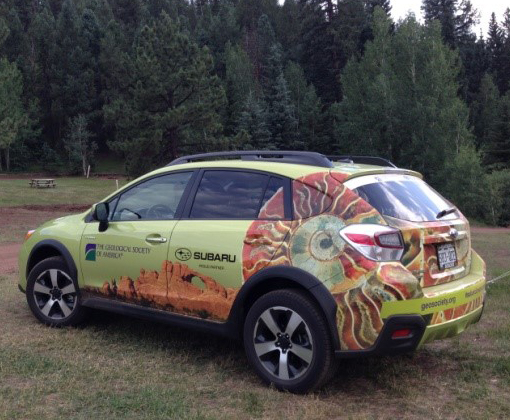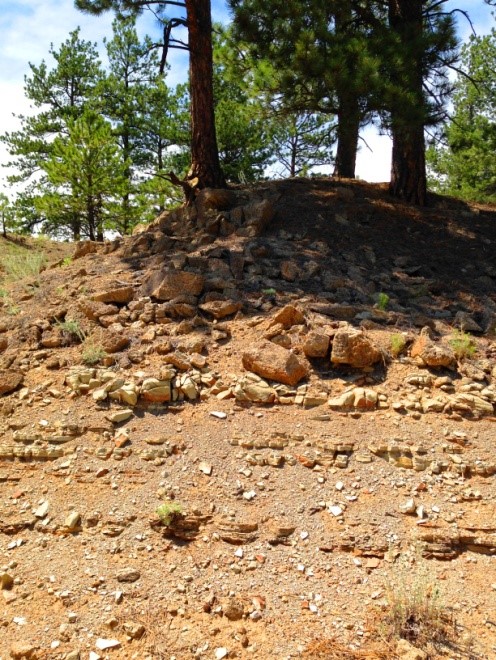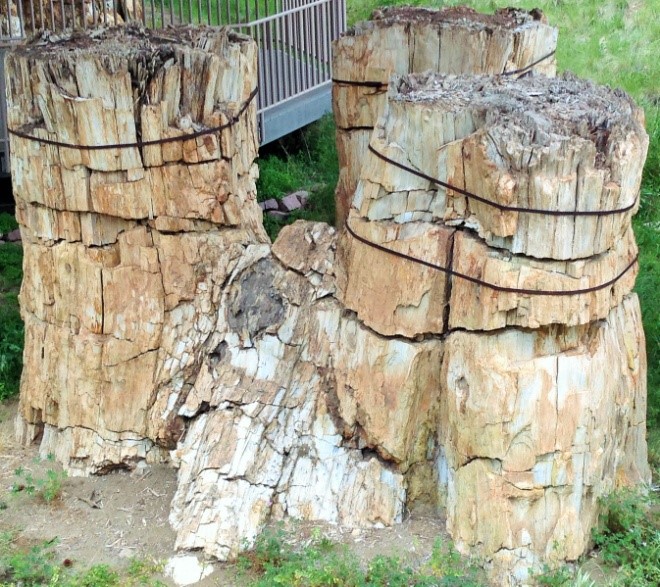By Aaron Currier, President, North America Research Group & Suzanne Galligher, Vice President and Show Chairman of the Paleontological Society of Austin

As amateur paleontologists and informal science learners, the prospect of joining “a paleontologist for three days of fossils, field work and discovery” at Florissant Fossil Beds National Monument in Colorado was an opportunity not to be missed. So we independently applied to and were chosen from numerous applicants to participate in a field course in July as sponsored representatives of the FOSSIL Project. Under the guidance of Dr. Dena Smith, paleobiologist at theUniversity of Colorado, we joined a group of middle school teachers on a project titled “Collaboration for Change: Fossil Plants and Ancient Climates.”
Imagine our surprise when Dena greeted us in a citron-colored Subaru covered with enormous ammonite graphics in Colorado Springs. Traveling to Florissant in a fossil car with a professional paleontologist – now that’s the start of a great adventure! As we traveled through millions of years of amazing geology, Dena shared her insights and stories, including some of her own adventures during research projects in the area.

We arrived at the Lost Burro Campground near the small town of Cripple Creek, a former gold mining camp, where we would call home for the next three days.[photo of landscape near the campground]. We were joined by Drs. Erin Leckey, Kristin Swihart and Tammy Maldonado, all based at CU Boulder. Accompanying us were three Denver area middle school educators—Erin M., Sarah, and Marilyn. [Aaron also is a middle school science teacher.] With introductions and construction of our “tent city” completed, anticipation grew for what was next.
We traveled together to the Florissant National Monument, just a few miles from camp. Florissant Fossil Beds National Monument is nestled in a valley to the west of Colorado Springs amid a verdant meadow 8400 feet above sea level. Today’s serene backdrop of distant mountain peaks, seemingly random uplifted granite outcrops, and rolling hills dotted with slender conifer trees belies a tumultuous period 34 to 35 million years ago when volcanic mudflows (lahars) surged into the valley and ash rained down from the Guffey volcanic complex. The eruption originated from a stratovolcano, similar to Mount St. Helens in the Cascades, 15 or so miles to the southwest. The debris flow dammed a stream bed that flowed through the Florissant valley creating the first lake (lower shale unit). Ongoing eruptions filled this lake with ash and mud until only shallow stream beds remained once again (lower mudstone unit).

In the late Eocene, majestic redwood trees proliferated near the stream bed banks in the valley until a subsequent cataclysmic eruption and volcanic mudflow destroyed nearly everything in its path. Most of the 500- to 750-year-old redwood forest was uprooted leaving only the bases of the most colossal redwoods entombed under 15 feet of debris becoming petrified in situ. Additional eruptions generated another lahar damming the stream beds once again to form a second generation lake (middle shale unit). The middle shale unit is what most visitors observe within the Monument today.

Lake Florissant flourished and teemed with life during this comparatively quiet period in its history. All good things must come to an end and so it was for Lake Florissant as a debris flow (caprock conglomerate unit) filled much of the lake. The greatly diminished lake (upper shale unit) hobbled along until a massive eruption of pumice and ash filled the lake basin once and for all (pumice conglomerate unit). The volcanic processes that led to so much destruction during the Eocene created a time capsule of exceptionally well preserved insect, plant and animal specimens that are still being unearthed today.


Walking along the grounds of Florissant, we were awestruck by the sheer size of the petrified redwood stumps that pepper the meadow. They are colossal – the largest of which measures 41 feet in circumference. These now extinct redwoods are related to the modern coastal redwoods of northern California and southern Oregon. By studying the growth rings of these petrified trunks, scientists discovered that the climatic conditions during Eocene Florissant enabled the redwoods to flourish in a much wider range than California redwoods of today. The mean annual temperature at Florissant during the late Eocene was about 56 degrees Fahrenheit, similar to modern day San Francisco; whereas, it is 39 degrees Fahrenheit today. Additionally, by cross dating the rings, it was revealed that the Florissant redwoods are all from a single forest. All told, there are more than 1700 species of flora and fauna that have been identified at Florissant with 1500 belonging to insects and spiders alone.
Inside the monument’s visitor center, there are fossils on display and interactive exhibits designed by researchers, including Dena. The exhibits not only highlight research discoveries, but include a connection to the researchers themselves. In Dena’s exhibit, for example, she is quoted “Growing up, all I ever heard was that girls and minorities were not good at science and math. Of course, I applied to college anyway, and look where I am now!”

We concluded our tour with a visit behind the scenes to see the collections, meet the research staff and learn about the various projects. We met Conni O’Connor, the Monument’s museum technician, and she showed us a few of the more notable specimens in the collection, including a fossilized bird that was recently found by an elementary student, and the bee fossil whose likeness has become the monument logo. We were also introduced to a few researchers who were on site as well. Current and recent research at Florissant includes
- Developing a technique for the stabilization of the fragile shale
- Stabilization of the fossil tree stumps
- Characterizing the preservation of the insect fossils
- Searching for small mammals in the Florissant Formation
- Climate change research using mollusks
- Identifying sources of volcanic ash in the Florissant Formation
- Climate comparisons with other fossiliferous formations
On the second day we headed toward town and the privately owned fossil dig site. On the way we stopped at the crossroads of one of the lahars. Dena shared how we were driving through the huge flow of mud and ash caused by volcanic eruptions that had collected rock debris and formed a natural dam that resulted in a lake. This intermittent lake was just what was needed to collect and preserve the millions of leaves and insects that can still be found at Florissant – some of which we were about to find ourselves.

Having a good idea how the Florissant fossil beds formed, we continued to Florissant Fossil Quarry to collect some specimens. We spent about two hours splitting the paper shale using razor blades and knives looking for leaves and insects. Some of the more notable finds were fossils of: Cattail (Typha); Sequoia branches; Fagopsis (Beech), Rhus (Sumac), Chamacyprus and Juncus leaves; seed pods; beetles; weevils (Curculionidae); wasps (Hymenoptera), and the March Fly (Bibionidae) Cedralospermum. Most of us also found the fresh water snail Planorbis. Notably some Beech leaves had insect damage. There was a lot of excitement by everyone as they collected and identified their specimens – some for the very first time. It was evident from this part of the workshop that hands-on activities are the most engaging and fun for teachers. It truly helps with the realization of just how amazing the fossil record is, particularly at Florissant.



We returned to the Monument and convened in the library for teacher lessons. Dena lectured on the geologic history of Earth, highlighting for teachers aspects that middle school students are likely to understand. It’s really good for teachers to also have a strong grasp of just how intricate and vast the current knowledge of the fossil record is, as well as the concept of deep time. Dena’s talk was followed by a fantastic lesson on leaves and climate by Erin Leckey. Erin gave us the task of recording the ratio of smooth to serrated edges to estimate annual average rainfall. We learned the smoother the leaves are on average, the warmer the climate. Similarly, measuring the length and width of leaf fossils and calculating surface area allowed us to estimate annual average rainfall. In this scenario, the larger the average leaf surface area, the wetter the climate. The lesson then entailed comparing data from a specific locality to see how the climate has changed over time, and then comparing to other localities to see differences between those data sets as well. This is a great lesson that we can adjust to fit any locality with leaf fossils and we can’t wait to try it back in Oregon and Texas.
For our final day of the workshop we heard another lecture, discussed teacher lessons and gave feedback. Erin M. explained how she put together her middle-school lessons on geologic history. We heard firsthand how the lessons worked and discussed ways to implement those lessons in our own curriculum back home. Opportunities like this to network and learn from colleagues are profoundly valuable – not just as a source for resources and ideas, but also motivation and inspiration.

Dena presented on insect ecology from Florissant and the Green River Formation in Colorado, showing numerous pictures of the amazing insects she is researching. She explained that she works at very different spatial and temporal scales in her research on insect biodiversity—conducting both in depth field-based research at targeted localities and large-scale, literature-based research across multiple geologic time intervals. She is also conducting studies in modern ecosystems and in the lab in order to learn more about the specifics of plant-insect interactions and processes of fossilization. One of her conclusions was very poignant. She reported that with higher average annual temperatures, there was more insect damage to the leaves. (She compared Florissant to Green River, which is about 13 million years older.) What she concluded was that “by looking at a time of climate change in the past, we can gain a better understanding of how our warming world may change in the future. As the world warms, we can expect to see an increase in insect damage to plants…with serious consequences for forests and essential food crops.”
As we reluctantly packed our identified specimens and teacher resources away and prepared to depart for home, we spent our final time together having a nice picnic on the monument grounds. We were joined by Park Director Dr. Herb Meyer and Suzanne’s family, who had traveled with her from Austin. We talked about how each of us were going to take what we learned back home and share it with our colleagues – and for many of us, our students. We are grateful to Dr. Smith, Dr. Meyer, the Florissant staff, field course teachers and the FOSSIL Project for the engaging field course and opportunity to learn so much about the Florissant Fossil Beds.
Aaron has already started to develop a template for lesson plans for teachers in Oregon to teach geologic history aimed at NGSS (Next Generation Science Standards) benchmarks. He is going to use Dr. Leckey’s lesson on Leaves and Climate Change. He wants to see if his students can make a correlation with the fossil leaves and the climate they infer from a nearby locality (that Dr. Meyer collected when he was a high school student in Oregon) with Oregon’s Bridge Creek Flora (John Day Fossil Formation) and perhaps even Florissant.
Suzanne plans to use the information gleaned from this trip to create an educational exhibit for paleontological society outreach. Additionally, she will adapt the classroom instructional materials and exercises provided during the field course into smaller, “bite-sized” pieces in order to accommodate the shorter time constraints that paleontological societies face when conducting K-12 and other educational outreach in the community. Lastly, the field course provided materials will be correlated to Texas teaching standards and disseminated to Texas teachers for classroom use.
Resources:

Paleontology of the Upper Eocene Florissant Formation, Colorado edited by Herbert W. Meyer and Dena M. Smith.
A comprehensive website documenting the Florissant fossil collections at 20 different museums (http://planning.nps.gov/flfo/)
The Fossils of Florissant by Herbert W. Meyer
Saved in Time: The Fight to Establish Florissant Fossil Beds National Monument, Colorado written by Estella Leopold and Herbert Meyer.